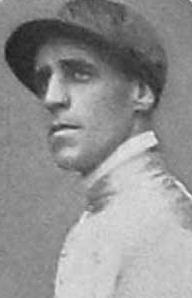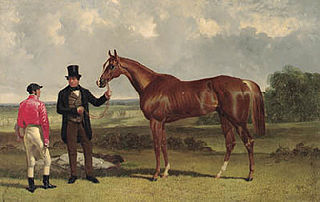
Johnny Murtagh is an Irish flat racing trainer and former jockey from Bohermeen, near Navan, Kells, County Meath. As a jockey he won many of the major flat races in Europe, including all the Irish Classics, all the Group 1 Races at Royal Ascot, The Derby, the King George VI and Queen Elizabeth Diamond Stakes and Europe's biggest race the Prix de l'Arc de Triomphe. He was also Irish flat racing Champion Jockey five times. As a trainer, based at stables near Kildare, he has saddled a winner at Royal Ascot and an Irish Classic winner.

Harry Wragg was a British jockey and racehorse trainer, who gained the nickname "The Head Waiter" due to his "come from behind" riding style. In a 27-year riding career, Wragg rode over 1700 winners in Britain and Ireland, including three victories in The Derby and ten in other British Classic Races. He then embarked on a successful 36-year training career, in which he trained many important winners including five more classics. He retired in 1982 and died three years later.

Bahram (1932–1956) was an Irish-bred, English-trained Thoroughbred racehorse. He was undefeated in nine races in a career that lasted from July 1934 until September 1935. He was one of the most impressive horses and was named "Horse of the century" and The leading British two-year-old of 1934. He went on to take the Triple Crown in 1935 by winning the 2000 Guineas Stakes, Epsom Derby, and St. Leger Stakes. He was retired to stud at the end of the year. After a promising start to his stud career in Britain, he was exported to the United States, where he had moderate success before being exported again to Argentina.

April the Fifth (1929–1954) was a British Thoroughbred racehorse and sire. In a career that lasted from September 1931 until September 1932 he ran nine times and won three races. He failed to win or be placed in his first five races, but then showed sudden improvement in the spring of 1932, winning his next three races including The Derby. His subsequent career was adversely affected by injury and after one more unsuccessful race he was retired to stud, where he had little impact as a sire of winners.

Tulyar (1949–1972) was an Irish bred, British-trained Thoroughbred racehorse and sire. He won The Derby, the St Leger Stakes, the King George VI & Queen Elizabeth Stakes, the Ormonde Stakes and the Eclipse Stakes setting a record for a single season's earnings in England. He stood at stud in Ireland and America, but failed to live up to expectations as a sire.
Trigo (1926–1946) was an Irish-bred British-trained Thoroughbred racehorse and sire. In a career which lasted from 1928 until September 1929, he ran ten times and won six races. Trained in Ireland as a two-year-old, he was then sent to be trained in England. In 1929 he won The Derby and the St. Leger Stakes before returning to Ireland to win the Irish St. Leger. He was then retired to stud where he had limited success.

Mahmoud (1933–1962) was a French-bred, British-trained Thoroughbred racehorse and sire. In a career which lasted from April 1935 to September 1936 he ran eleven times and won four races. In 1935 he won two of Britain's most important two-year-old races and was officially rated the second-best colt of his generation. In 1936 he won only once from five starts, but this win came in the Derby in which he set a race record which stood for fifty-nine years, and became the third of only four greys to win the race. After being retired from racing he was sold and exported to the United States, where he became a highly successful breeding stallion and was America's Champion sire in 1946.

Mid-day Sun (1934–1954) was a British Thoroughbred racehorse and sire. After showing little promise as a two-year-old in 1936, Mid-day Sun improved into top class performer at three. In 1937 he won five races including The Derby and the Hardwicke Stakes at Royal Ascot. He was retired to stud in 1938 but had little success as a stallion. He was the first winner of the Derby at Epsom to be owned by a woman.

Charles James William Smirke (1906–1993), was a British flat-race jockey. In a career that lasted from 1920 until 1959, he rode the winners of eleven British Classic Races. As a rider, he was known for his skill, strength and tactical intelligence, together with his self-confident and outspoken personality. Although he never won the Championship, he was regarded as one of the best jockeys of his era. The Racing Post ranked him as the fifth greatest jockey of the 20th Century and the greatest never to have been champion.

Orwell (1929–1948), also known as the Golden Hair Colt, was a British Thoroughbred racehorse and sire. In a career that lasted from June 1931 to September 1932 he ran eleven times and won eight races. He was the leading British two-year-old of his generation, winning five successive races in 1931 including the Champagne Stakes and the Middle Park Stakes. During this season he was one of the last notable racehorses to race without being officially named. The following year he won the 2000 Guineas at Newmarket but was beaten when starting favourite for both The Derby and the St. Leger Stakes. At the end of 1932 he was retired to stud, where his record was disappointing.

Joseph Childs (1884–1958) was a French-born, British-based flat racing jockey. He won fifteen British Classics in a 35-year career, the last ten years of which were spent as jockey to King George V. He was known for riding a slow, waiting race, and also for having a short temper which regularly saw him at odds with his trainers and owners.
Tehran (1941–1966) was a British Thoroughbred racehorse and sire, who raced during World War II and was best known for winning the classic St Leger in 1944. After showing little ability as a two-year-old he improved in the following spring to win the Culford Stakes on his three-year-old debut. He ran third in the 2000 Guineas and was narrowly beaten into second place in the Derby Stakes. After winning the Whepstead Stakes he recorded his biggest win when defeating a strong field in a substitute St Leger. He won his first three races in 1945 and finished second in the Ascot Gold Cup. He later became a successful breeding stallion, siring several major winners including Tulyar.
Turkhan was a British Thoroughbred racehorse and sire, who raced during World War II and was best known for winning the classic St Leger in 1940. He showed good form as a two-year-old, winning the Coventry Stakes at Royal Ascot. In the following year he finished second in the rescheduled New Derby and won the Irish Derby before taking a substitute Yorkshire St Leger at Thirsk Racecourse in November. He was then retired to stud where he made little impact as a breeding stallion.
Felicitation was a British Thoroughbred racehorse and sire. A specialist stayer, owned and bred by the Aga Khan he was best known for his emphatic victory over a very strong international field in the 1934 Ascot Gold Cup. He was one of the best two-year-olds of his generation in England in 1932 when he was awarded the Middle Park Stakes on the disqualification of Manitoba. He failed to win in eight starts as a three-year-old but ran well to finish second in to Hyperion in the St Leger. In the summer of 1934 he established himself as one of the best horses in Europe by winning the Ascot Gold Cup, John Porter Stakes and Jockey Club Cup as well as finishing third in the Prix de l'Arc de Triomphe. He was injured when winning the Yorkshire Cup as a five-year-old and was retired from racing. He stood as a breeding stallion in England and Brazil with moderate results.

Job Marson (1817–1857) was an English classic-winning jockey, whose most famous partnership was with Voltigeur, winner of the 1850 Derby and St Leger.
Udaipur was a British Thoroughbred racehorse and broodmare. Her racing career consisted of eight races between April and October 1932. Having finished second on her debut and seventh in the 1000 Guineas she was still a maiden when she recorded her biggest win in the Epsom Oaks in June. She went on to win the Coronation Stakes, Richemont Stakes and Newmarket Oaks as well as finishing fourth in a strong edition of the St Leger. As a broodmare she produced several good winners and was the female-line ancestor of Wild Again.

Firdaussi was a British Thoroughbred racehorse and sire. He showed very good form as a two-year-old in 1931 when he won three of his five races including the Dewhurst Stakes. In the following year his progress was interrupted by illness in spring but he won his last four races, taking the Gordon Stakes before recording his biggest win in the St Leger and then defeating top-class older horses in the Jockey Club Stakes. He ran consistently as a four-year-old in 1933 but won only one minor race. Apart from his victories, Firdaussi was placed in the Eclipse Stakes (twice), Greenham Stakes, Lingfield Derby Trial and Great Jubilee Handicap. After his retirement from racing Firdaussi stood as a breeding stallion in Britain, France and Ireland, but had limited success as a sire of winners.
Joe Marshall (1908–1973) was a flat racing jockey, who won the 1929 Derby on Trigo.
Eric Ephraim Smith was an English flat racing jockey, who rode over 2,000 winners, including the winners of three Classics, in a career spanning over 30 years. He was three times the British flat racing Champion Apprentice and was ranked 23rd in the Racing Post's top 50 jockeys of the 20th century.

Bernard "Brownie" Carslake was an Australian-born, but mainly England-based, flat racing jockey, who in a career of over three decades won every British Classic except the Derby, as well as becoming champion jockey of Austria-Hungary and Russia. He was ranked 12th in the Racing Post jockeys of the 20th Century.













